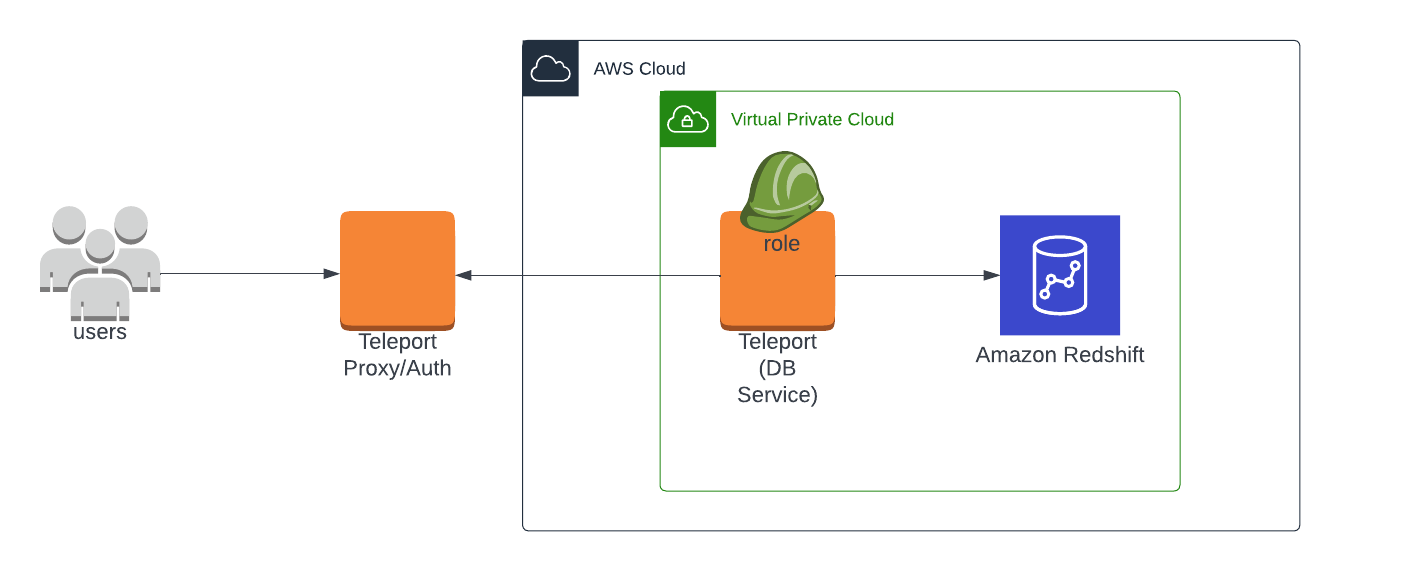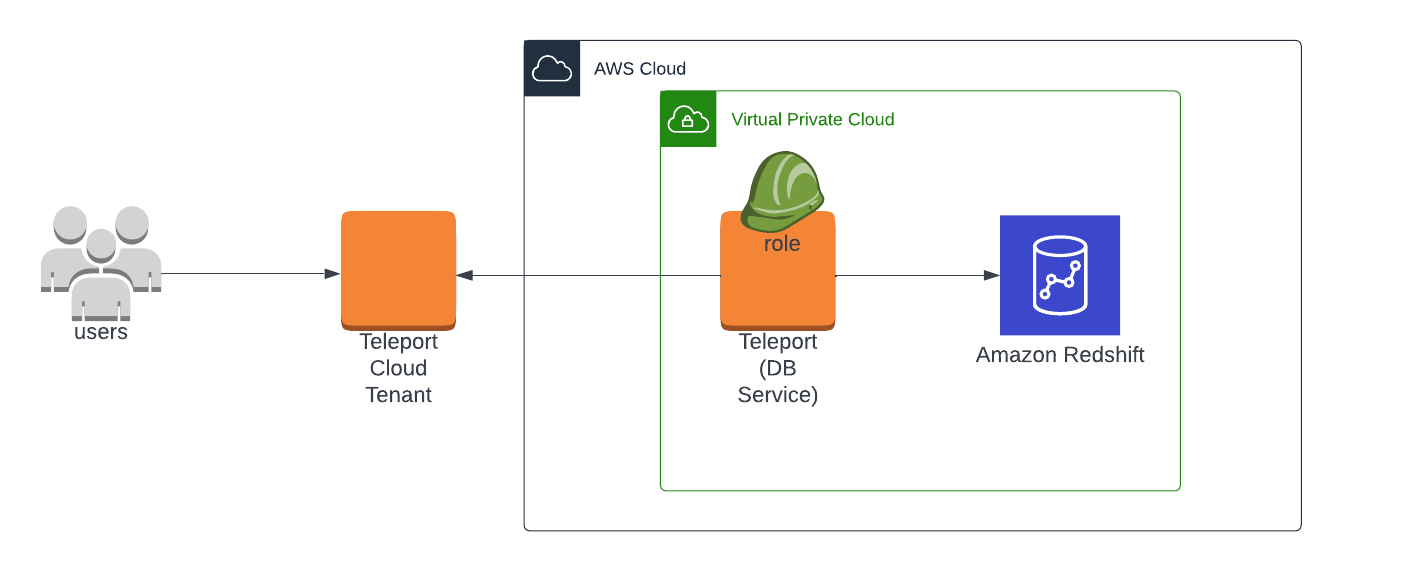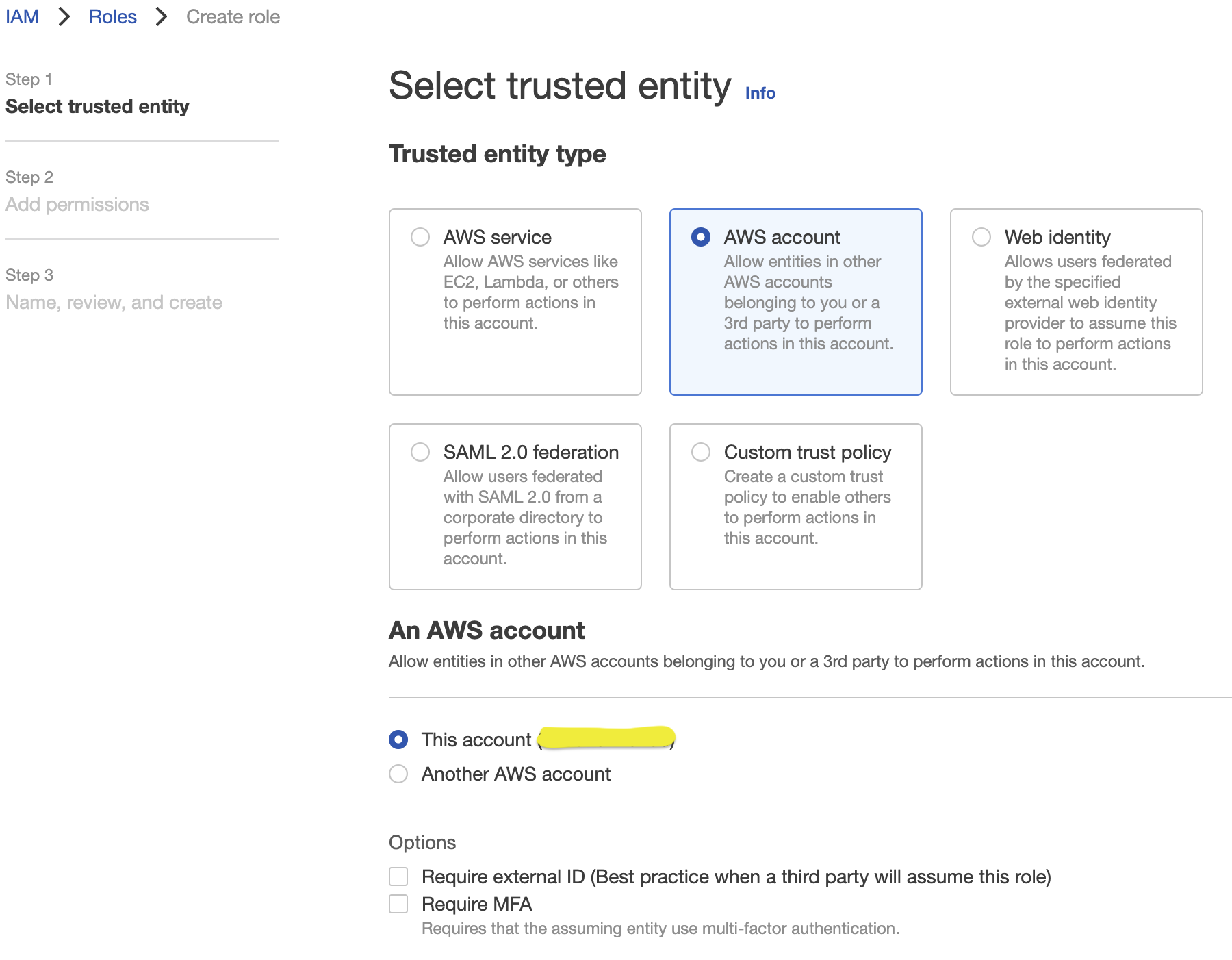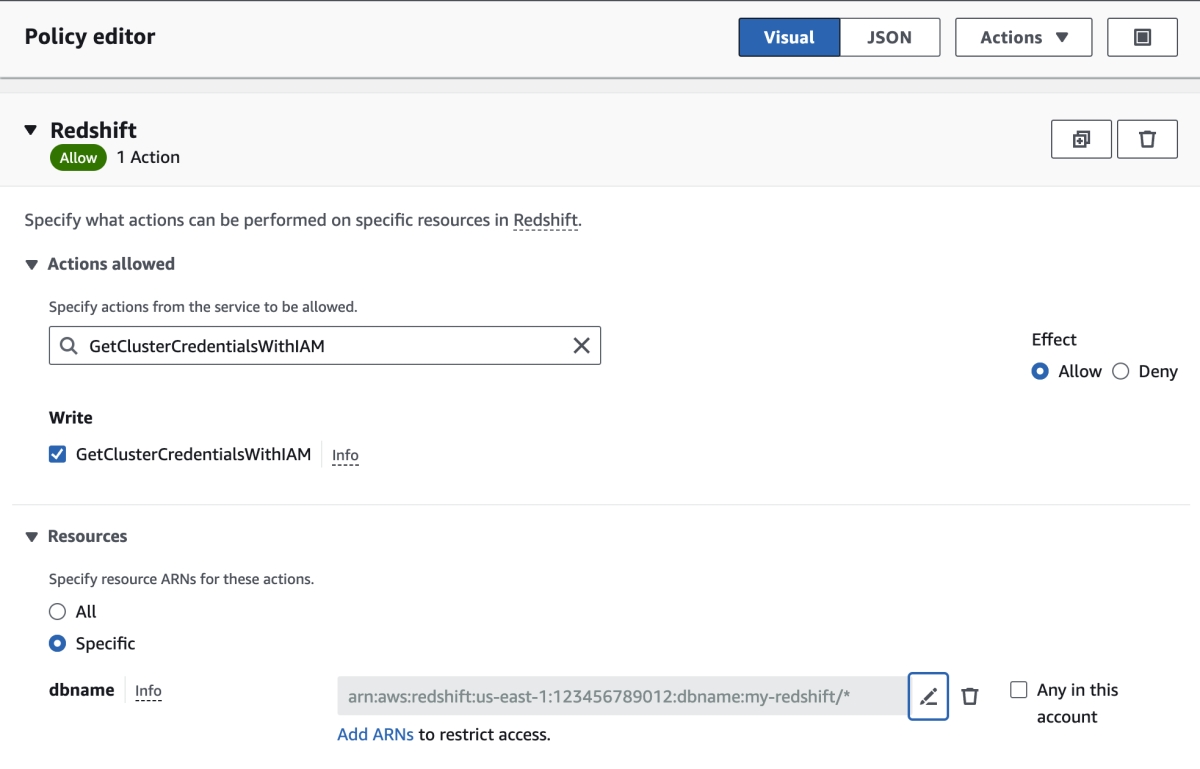Database Access with Redshift on AWS
Teleport can provide secure access to Amazon Redshift via the Teleport Database Service. This allows for fine-grained access control through Teleport's RBAC.
In this guide, you will:
- Configure your Amazon Redshift database with IAM authentication.
- Add the database to your Teleport cluster.
- Connect to the database via Teleport.
How it works
The Teleport Database Service uses IAM authentication to communicate with Amazon Redshift. When a user connects to the database via Teleport, the Teleport Database Service obtains AWS credentials and authenticates to AWS as an IAM principal with permissions to manage the database.
- Self-Hosted
- Teleport Enterprise Cloud


This guide shows how to register a single Amazon Redshift cluster with your Teleport cluster. For a more scalable approach, learn how to set up Database Auto-Discovery to automatically enroll all AWS databases in your infrastructure.
Prerequisites
-
A running Teleport cluster version 15.4.22 or above. If you want to get started with Teleport, sign up for a free trial or set up a demo environment.
-
The
tctladmin tool andtshclient tool.On Teleport Enterprise, you must use the Enterprise version of
tctl, which you can download from your Teleport account workspace. Otherwise, visit Installation for instructions on downloadingtctlandtshfor Teleport Community Edition.
- AWS account with a Redshift cluster and permissions to create and attach IAM policies.
- Command-line client
psqlinstalled and added to your system'sPATHenvironment variable. - A host, e.g., an EC2 instance, where you will run the Teleport Database Service.
- To check that you can connect to your Teleport cluster, sign in with
tsh login, then verify that you can runtctlcommands using your current credentials.tctlis supported on macOS and Linux machines. For example:If you can connect to the cluster and run the$ tsh login --proxy=teleport.example.com [email protected]
$ tctl status
# Cluster teleport.example.com
# Version 15.4.22
# CA pin sha256:abdc1245efgh5678abdc1245efgh5678abdc1245efgh5678abdc1245efgh5678tctl statuscommand, you can use your current credentials to run subsequenttctlcommands from your workstation. If you host your own Teleport cluster, you can also runtctlcommands on the computer that hosts the Teleport Auth Service for full permissions.
Step 1/6. Create a Teleport user
To modify an existing user to provide access to the Database Service, see Database Access Controls
- Teleport Community Edition
- Teleport Enterprise/Enterprise Cloud
Create a local Teleport user with the built-in access role:
$ tctl users add \
--roles=access \
--db-users="*" \
--db-names="*" \
alice
Create a local Teleport user with the built-in access and requester roles:
$ tctl users add \
--roles=access,requester \
--db-users="*" \
--db-names="*" \
alice
| Flag | Description |
|---|---|
--roles | List of roles to assign to the user. The builtin access role allows them to connect to any database server registered with Teleport. |
--db-users | List of database usernames the user will be allowed to use when connecting to the databases. A wildcard allows any user. |
--db-names | List of logical databases (aka schemas) the user will be allowed to connect to within a database server. A wildcard allows any database. |
Database names are only enforced for PostgreSQL, MongoDB, and Cloud Spanner databases.
For more detailed information about database access controls and how to restrict access see RBAC documentation.
Step 2/6. Create a Database Service configuration
The Database Service requires a valid join token to join your Teleport cluster.
Run the following tctl command and save the token output in /tmp/token
on the server that will run the Database Service:
$ tctl tokens add --type=db --format=text
abcd123-insecure-do-not-use-this
Alternative methods
For users with a lot of infrastructure in AWS, or who might create or recreate many instances, consider alternative methods for joining new EC2 instances running Teleport:
Install Teleport on your Linux server:
-
Assign edition to one of the following, depending on your Teleport edition:
Edition Value Teleport Enterprise Cloud cloudTeleport Enterprise (Self-Hosted) enterpriseTeleport Community Edition oss -
Get the version of Teleport to install. If you have automatic agent updates enabled in your cluster, query the latest Teleport version that is compatible with the updater:
$ TELEPORT_DOMAIN=example.teleport.com
$ TELEPORT_VERSION="$(curl https://$TELEPORT_DOMAIN/v1/webapi/automaticupgrades/channel/default/version | sed 's/v//')"Otherwise, get the version of your Teleport cluster:
$ TELEPORT_DOMAIN=example.teleport.com
$ TELEPORT_VERSION="$(curl https://$TELEPORT_DOMAIN/v1/webapi/ping | jq -r '.server_version')" -
Install Teleport on your Linux server:
$ curl https://cdn.teleport.dev/install-v15.4.22.sh | bash -s ${TELEPORT_VERSION} editionThe installation script detects the package manager on your Linux server and uses it to install Teleport binaries. To customize your installation, learn about the Teleport package repositories in the installation guide.
On the node that is running the Database Service, create a configuration file.
Assign CLUSTER_URI to the domain name and port of the cluster:
- Self-Hosted
- Teleport Enterprise Cloud
$ sudo teleport db configure create \
-o file \
--name="redshift-postgres" \
--proxy=teleport.example.com:3080 \
--protocol=postgres \
--token=/tmp/token \
--uri=${CLUSTER_URI?}
$ sudo teleport db configure create \
-o file \
--name="redshift-postgres" \
--proxy=mytenant.teleport.sh:443 \
--protocol=postgres \
--token=/tmp/token \
--uri=${CLUSTER_URI?}
The command will generate a Database Service configuration to proxy your AWS
Redshift cluster place it at the /etc/teleport.yaml location.
Step 3/6. Create an IAM Role for user access (optional)
Redshift supports two methods of IAM authentication, both of which Teleport also supports.
First is IAM authentication as a database user. In this method, the Teleport Database Service generates a temporary IAM authentication token for a database user that already exists in the Redshift database. If you choose to use this method, you can skip this step as no additional IAM roles are required.
The second method is to authenticate as an IAM role. In this case, the Teleport Database Service assumes an IAM role to authenticate with Redshift. Redshift then maps that IAM role to a database username and creates that database user if it doesn't already exist in the database.
If you choose the second method, create the AWS IAM role to provide user access to the Redshift database. Go to IAM -> Access Management -> Roles, and click "Create Role".

Skip "Add permissions" for now, enter a role name, and press "Create role".
Once the role is created, find the role, and add the following inline policy to
the IAM role:

Or in JSON format:
{
"Version": "2012-10-17",
"Statement": [
{
"Effect": "Allow",
"Action": "redshift:GetClusterCredentialsWithIAM",
"Resource": "arn:aws:redshift:us-east-1:123456789012:dbname:my-redshift/*"
}
]
}
Replace 123456789012 and my-redshift with your AWS account ID and your
Redshift database's cluster ID.
Step 4/6. Create an IAM policy for the Database Service
Teleport needs AWS IAM permissions to be able to:
- Manage IAM user or IAM role policies, for IAM authentication as database users.
- Assume IAM roles, for IAM authentication as IAM roles.
Before you can generate IAM permissions, you must provide the Teleport Database Service access to AWS credentials.
Grant the Database Service access to credentials that it can use to authenticate to AWS. If you are running the Database Service on an EC2 instance, you may use the EC2 Instance Metadata Service method. Otherwise, you must use environment variables:
- Instance Metadata Service
- Environment Variables
Teleport will detect when it is running on an EC2 instance and use the Instance Metadata Service to fetch credentials.
The EC2 instance should be configured to use an EC2 instance profile. For more information, see: Using Instance Profiles.
Teleport's built-in AWS client reads credentials from the following environment variables:
AWS_ACCESS_KEY_IDAWS_SECRET_ACCESS_KEYAWS_DEFAULT_REGION
When you start the Database Service, the service reads environment variables from a
file at the path /etc/default/teleport. Obtain these credentials from your
organization. Ensure that /etc/default/teleport has the following content,
replacing the values of each variable:
AWS_ACCESS_KEY_ID=00000000000000000000
AWS_SECRET_ACCESS_KEY=0000000000000000000000000000000000000000
AWS_DEFAULT_REGION=<YOUR_REGION>
Have multiple sources of AWS credentials?
Teleport's AWS client loads credentials from different sources in the following order:
- Environment Variables
- Shared credentials file
- Shared configuration file (Teleport always enables shared configuration)
- EC2 Instance Metadata (credentials only)
While you can provide AWS credentials via a shared credentials file or shared
configuration file, you will need to run the Database Service with the AWS_PROFILE
environment variable assigned to the name of your profile of choice.
If you have a specific use case that the instructions above do not account for, consult the documentation for the AWS SDK for Go for a detailed description of credential loading behavior.
Teleport can bootstrap IAM permissions for the Database Service based on its
configuration using the teleport db configure bootstrap command. You can use
this command in automatic or manual mode:
- In automatic mode, Teleport will attempt to create appropriate IAM policies and attach them to the specified IAM identity role. This requires IAM permissions to create and attach IAM policies.
- In manual mode, Teleport will print required IAM policies. You can then create and attach them manually using the AWS management console.
- Automatic IAM setup
- Manual IAM setup
Use this command to bootstrap the permissions automatically when your Teleport Database Service runs as an IAM role (for example, on an EC2 instance with an attached IAM role).
$ teleport db configure bootstrap -c /etc/teleport.yaml --attach-to-role TeleportRole
Use this command to display required IAM policies which you will then create in your AWS console:
$ teleport db configure bootstrap -c /etc/teleport.yaml --manual --attach-to-role arn:aws:iam::123456789012:role/TeleportRole
Bootstrapping with assume_role_arn in config
When assume_role_arn is configured for databases or AWS matchers,
teleport db configure bootstrap will determine permissions required for the
bootstrap target AWS IAM identity using the following logic:
- When the target does not match
assume_role_arnin any database resource or AWS matcher in the configuration file, the target is assumed to be the Teleport Database Service's AWS IAM identity and permissions are bootstrapped for all the configured static databases and AWS matchers. - When an
--attach-to-roletarget matches anassume_role_arnsetting for static databases or AWS matchers in the configuration file, permissions will be bootstrapped only for those static databases or AWS matchers.
You will need to run the bootstrap command once with the Teleport Database
Service's IAM identity as the policy attachment target, and once for each AWS
IAM role that is used for assume_role_arn.
Step 5/6. Start the Database Service
Configure the Database Service to start automatically when the host boots up by creating a systemd service for it. The instructions depend on how you installed the Database Service.
- Package Manager
- TAR Archive
On the host where you will run the Database Service, enable and start Teleport:
$ sudo systemctl enable teleport
$ sudo systemctl start teleport
On the host where you will run the Database Service, create a systemd service configuration for Teleport, enable the Teleport service, and start Teleport:
$ sudo teleport install systemd -o /etc/systemd/system/teleport.service
$ sudo systemctl enable teleport
$ sudo systemctl start teleport
You can check the status of the Database Service with systemctl status teleport
and view its logs with journalctl -fu teleport.
The Database Service will proxy the Amazon Redshift cluster with the ID you specified earlier. Keep in mind that AWS IAM changes may not propagate immediately and can take a few minutes to come into effect.
Step 6/6. Connect
- Self-Hosted
- Teleport Enterprise Cloud
Once the Database Service has started and joined the cluster, log in to see the
registered databases. Replace --proxy with the address of your Teleport Proxy
Service.
$ tsh login --proxy=teleport.example.com --user=alice
$ tsh db ls
# Name Description Labels
# ----------- ------------------------------ --------
# my-redshift ...
Once the Database Service has started and joined the cluster, log in to see the
registered databases. Replace --proxy with the address of your Teleport Cloud
tenant.
$ tsh login --proxy=mytenant.teleport.sh --user=alice
$ tsh db ls
# Name Description Labels
# ----------- ------------------------------ --------
# my-redshift ...
To retrieve credentials for a database and connect to it:
- Authenticate as database users
- Authenticate as IAM roles
$ tsh db connect --db-user=alice --db-name=dev my-redshift
Teleport does not currently use the auto-create option when generating tokens for Redshift databases. Users must exist in the database.
$ tsh db connect --db-user=role/my-iam-role --db-name=dev my-redshift
To log out of the database and remove credentials:
$ tsh db logout my-redshift
Troubleshooting
Certificate error
If your tsh db connect error includes the following text, you likely have an RDS database created before July 28, 2020, which presents an X.509 certificate that is incompatible with Teleport:
x509: certificate relies on legacy Common Name field, use SANs instead
AWS provides instructions to rotate your SSL/TLS certificate.
No credential providers error
If you see the error NoCredentialProviders: no valid providers in chain in Database Service logs then Teleport
is not detecting the required credentials to connect via AWS IAM permissions. Check whether
the credentials or security role has been applied in the machine running the Teleport Database Service.
When running on EKS, this error may occur if the Teleport Database Service cannot access IMDSv2 when the PUT requests hop limit on the worker node instance is set to 1. You can use the following commands to check the hop limit:
$ aws ec2 describe-instances --instance-ids <node-instance-id> | grep HttpPutResponseHopLimit
"HttpPutResponseHopLimit": 1,
See IMDSv2 support for EKS and EKS best practices for more details.
Timeout errors
The Teleport Database Service needs connectivity to your database endpoints. That may require
enabling inbound traffic on the database from the Database Service on the same VPC or routing rules from another VPC. Using the nc
program you can verify connections to databases:
$ nc -zv postgres-instance-1.sadas.us-east-1.rds.amazonaws.com 5432
# Connection to postgres-instance-1.sadas.us-east-1.rds.amazonaws.com (172.31.24.172) 5432 port [tcp/postgresql] succeeded!
Not authorized to perform sts:AssumeRole
The Database Service assumes an IAM role in one of following situations:
- An IAM role is used as
db_userwhen accessing AWS services that require IAM roles as database users, such as DynamoDB, Keyspaces, Opensearch, and Redshift Serverless. - The
assume_role_arnfield is specified for the database resources or dynamic resource matchers.
Role chaining
When both of the above conditions are true for a database connection, the
Database Service performs a role chaining by assuming the IAM role specified
assume_role_arn first then using that IAM role to assume the IAM role for
db_user.
You may encounter the following error if the trust relationship is not configured properly between the IAM roles:
AccessDenied: User: arn:aws:sts::111111111111:assumed-role/database-service-role/i-* is not authorized to perform: sts:AssumeRole on resource: arn:aws:iam::111111111111:role/database-user-role
To allow IAM Role role1 to assume IAM Role role2, the following is
generally required:
1. Configure Trust Relationships on role2
role1 or its AWS account should be set as Principal in role2's trust
policy.
- Role as principal
- Account as principal
- Cross-account with external-id
{
"Version": "2012-10-17",
"Statement": [
{
"Effect": "Allow",
"Principal": {
"AWS": "arn:aws:iam::aws-account-id:role/role1"
},
"Action": "sts:AssumeRole"
}
]
}
{
"Version": "2012-10-17",
"Statement": [
{
"Effect": "Allow",
"Principal": {
"AWS": "arn:aws:iam::aws-account-id:root"
},
"Action": "sts:AssumeRole"
}
]
}
{
"Version": "2012-10-17",
"Statement": [
{
"Effect": "Allow",
"Principal": {
"AWS": "arn:aws:iam::external-aws-account-id:role/role1"
},
"Action": "sts:AssumeRole",
"Condition": {
"StringEquals": {
"sts:ExternalId": "example-external-id"
}
}
}
]
}
2. Configure Permissions Policies on role1
role1 requires sts:AssumeRole permissions, for example:
{
"Version": "2012-10-17",
"Statement": [
{
"Action": "sts:AssumeRole",
"Effect": "Allow",
"Resource": "arn:aws:iam::aws-account-id:role/role2"
}
]
}
Note that this policy can be omitted when role1 and role2 are in the same
AWS account and role1's full ARN is configured as Principal in role2's
trust policy.
3. Configure Permissions Boundary on role1
role1 also requires sts:AssumeRole permissions in its boundary policy, for
example:
{
"Version": "2012-10-17",
"Statement": [
{
"Action": "sts:AssumeRole",
"Effect": "Allow",
"Resource": "*"
}
]
}
Note that this is only required when a boundary policy is attached to role1.
You can test the trust relationship by running this AWS CLI command as role1:
aws sts assume-role --role-arn arn:aws:iam::111111111111:role/role2 --role-session-name test-trust-relationship
Learn more on how to use trust policies with IAM roles.
Maximum policy size exceeded errors
Due to IAM and STS character limits, you may encounter one of the following errors in the Database Service logs when large numbers of databases are registered:
LimitExceeded: Maximum policy size of 2048 bytes exceeded for user <iam-user>LimitExceeded: Maximum policy size of 10240 bytes exceeded for role <iam-role>
For reference, a user policy can maintain permissions for approximately 6 Redshift databases, or 20 RDS databases due to the IAM policy character limits. A role policy can maintain permissions for approximately 30 Redshift databases, or 100 RDS databases.
To get around this limit, try using one or a combination of the following methods:
Method 1: Organize IAM roles with "assume_role_arn"
You can reduce the policy size by separating them into multiple IAM roles. Use
assume_role_arn to specify different IAM roles for accessing the databases:
- Auto-Discovery by Discovery Service
- Auto-Discovery by Database Service
- Static config
- Other dynamic resources
You can specify assume_role_arn in the AWS matchers of Discovery Service's
configuration:
discovery_service:
enabled: "yes"
aws:
- types: ["rds"]
regions: ["us-west-1", "us-west-2"]
assume_role_arn: "arn:aws:iam::123456789012:role/example-role-rds-env-prod-discovery"
tags:
"env": "prod"
- types: ["redshift", "redshift-serverless"]
regions: ["us-west-2"]
assume_role_arn: "arn:aws:iam::123456789012:role/example-role-redshift-env-dev"
tags:
"env": "dev"
The Discovery Service will use the IAM roles specified in assume_role_arn
for discovery, and by default the Database Service will use the same IAM
roles for authentication.
However, you can also overwrite the IAM roles for authentication by Database Service if you wish to use different roles:
db_service:
enabled: "yes"
resources:
# Matches us-west-1 env=prod RDS databases from Discovery Service, and
# overwrites assume_role_arn.
- labels:
"env": "prod"
"region": "us-west-1"
aws:
assume_role_arn: "arn:aws:iam::123456789012:role/example-role-rds-env-prod-us-west-1-access"
# Matches us-west-2 env=prod RDS databases from Discovery Service, and
# overwrites assume_role_arn.
- labels:
"env": "prod"
"region": "us-west-2"
aws:
assume_role_arn: "arn:aws:iam::123456789012:role/example-role-rds-env-prod-us-west-2-access"
# Matches env=dev Redshift databases from Discovery Service and inherits
# "arn:aws:iam::123456789012:role/example-role-redshift-env-dev"
- labels:
"env": "dev"
Teleport generates certain labels derived from the cloud resource attributes during discovery. See Auto-Discovery labels /labels/#auto-discovery) for more details.
Create or print the required IAM policies with the following commands and attach them to the respective IAM roles:
$ teleport db configure aws create-iam --types redshift,redshift-serverless --name teleport-redshift-access
$ teleport db configure aws print-iam --types redshift,redshift-serverless
Refer to the command usage for a complete list of database types supported by
the --types option.
You can specify assume_role_arn in the AWS matchers of Database Service's
configuration:
db_service:
enabled: "yes"
aws:
- types: ["rds"]
regions: ["us-west-1", "us-west-2"]
assume_role_arn: "arn:aws:iam::123456789012:role/example-role-rds-env-prod"
tags:
"env": "prod"
- types: ["redshift", "redshift-serverless"]
regions: ["us-west-2"]
assume_role_arn: "arn:aws:iam::123456789012:role/example-role-redshift-env-dev"
tags:
"env": "dev"
The Database Service will use the IAM roles specified assume_role_arn for
both discovery and authentication.
To bootstrap IAM permissions, run the bootstrap command for each assume_role_arn:
$ teleport db configure bootstrap \
-c /etc/teleport.yaml \
--policy-name teleport-policy-rds-env-prod \
--attach-to-role "arn:aws:iam::123456789012:role/example-role-rds-env-prod"
You can specify aws.assume_role_arn when defining databases in Database
Service's configuration:
db_service:
enabled: "yes"
databases:
- name: "rds-postgres"
protocol: "postgres"
uri: "rds-postgres.abcdef012345.us-west-1.rds.amazonaws.com:5432"
aws:
assume_role_arn: "arn:aws:iam::123456789012:role/example-rds-access-role"
To bootstrap IAM permissions, run the bootstrap command for each assume_role_arn:
$ teleport db configure bootstrap \
-c /etc/teleport.yaml \
--policy-name teleport-policy-rds-access \
--attach-to-role "arn:aws:iam::123456789012:role/example-rds-access-role"
You can specify aws.assume_role_arn when defining databases:
kind: db
version: v3
metadata:
name: "rds-postgres"
labels:
env: "dev"
spec:
protocol: "postgres"
uri: "rds-postgres.abcdef012345.us-west-1.rds.amazonaws.com:5432"
aws:
assume_role_arn: "arn:aws:iam::123456789012:role/example-rds-access-role"
Alternatively, you can overwrite the IAM roles for authentication by Database Service:
db_service:
enabled: "yes"
resources:
# Matches env=dev databases and overwrites assume_role_arn.
- labels:
"env": "dev"
aws:
assume_role_arn: "arn:aws:iam::123456789012:role/example-env-dev-access"
# Matches env=prod database, and use the assume_role_arn in the database's
# definition or use the host IAM identity if assume_role_arn is empty.
- labels:
"env": "prod"
Create or print the required IAM policies with the following commands and attach them to the respective IAM roles:
$ teleport db configure aws create-iam --types rds --name teleport-rds-access
$ teleport db configure aws print-iam --types rds
Refer to the command usage for a complete list of database types supported by
the --types option.
The IAM roles specified in assume_role_arn must
trust
the IAM identity of the host running the Database Service.
The assume_role_arn is not limited to the same AWS account so you can also
use this feature for AWS Cross-Account
Access.
Method 2: Manually manage your IAM policies
You can manually manage IAM policies for database connections instead of relying on the Database Service to update them.
For example, you can limit the character size by attaching a policy with a wildcard "*" for "Resource":
- RDS or RDS Proxy
- Redshift
{
"Version": "2012-10-17",
"Statement": [
{
"Effect": "Allow",
"Action": "rds-db:connect",
"Resource": "*"
}
]
}
{
"Version": "2012-10-17",
"Statement": [
{
"Effect": "Allow",
"Action": "redshift:GetClusterCredentials",
"Resource": "*"
}
]
}
You can safely remove the inline policy created by the Database Service and the
IAM permissions for the Database Service to Get/Put/Delete the user or role
policy.
Method 3: Separate Database Services
You can deploy the Database Service in a highly available (HA) configuration where databases can be sharded to separate Database Services with different IAM roles.
Method 4: Use IAM roles instead of IAM users
IAM users have a lower character limit compared to IAM roles. If the limit is exceeded for a user policy, it is recommended to use IAM roles for the Database Service instead.
Unable to cancel a query
If you use a PostgreSQL cli client like psql, and you try to cancel a query
with ctrl+c, but it doesn't cancel the query, then you need to connect using a
tsh local proxy instead.
When psql cancels a query, it establishes a new connection without TLS
certificates, however Teleport requires TLS certificates not only for
authentication, but also to route database connections.
If you
enable TLS Routing in Teleport
then tsh db connect will automatically start a local proxy for every
connection.
Alternatively, you can connect via
Teleport Connect
which also uses a local proxy.
Otherwise, you need to start a tsh local proxy manually using tsh proxy db
and connect via the local proxy.
If you have already started a long-running query in a psql session that you
cannot cancel with ctrl+c, you can start a new client session to cancel that
query manually:
First, find the query's process identifier (PID):
SELECT pid,starttime,duration,trim(user_name) AS user,trim(query) AS query FROM stv_recents WHERE status = 'Running';
Next, gracefully cancel the query using its PID. This will send a SIGINT signal to the postgres backend process for that query:
SELECT pg_cancel_backend(<PID>);
You should always try to gracefully terminate a query first, but if graceful cancellation is taking too long, then you can forcefully terminate the query instead. This will send a SIGTERM signal to the postgres backend process for that query:
SELECT pg_terminate_backend(<PID>);
See the PostgreSQL documentation on
admin functions
for more information about the pg_cancel_backend and pg_terminate_backend
functions.
SSL SYSCALL error
You may encounter the following error when your local psql is not compatible
with newer versions of OpenSSL:
$ tsh db connect --db-user postgres --db-name postgres postgres
psql: error: connection to server at "localhost" (::1), port 12345 failed: Connection refused
Is the server running on that host and accepting TCP/IP connections?
connection to server at "localhost" (127.0.0.1), port 12345 failed: SSL SYSCALL error: Undefined error: 0
Please upgrade your local psql to the latest version.
Next steps
- Learn more about using IAM authentication to generate database user credentials for Amazon Redshift.
- Learn how to restrict access to certain users and databases.
- View the High Availability (HA) guide.
- Take a look at the YAML configuration reference.